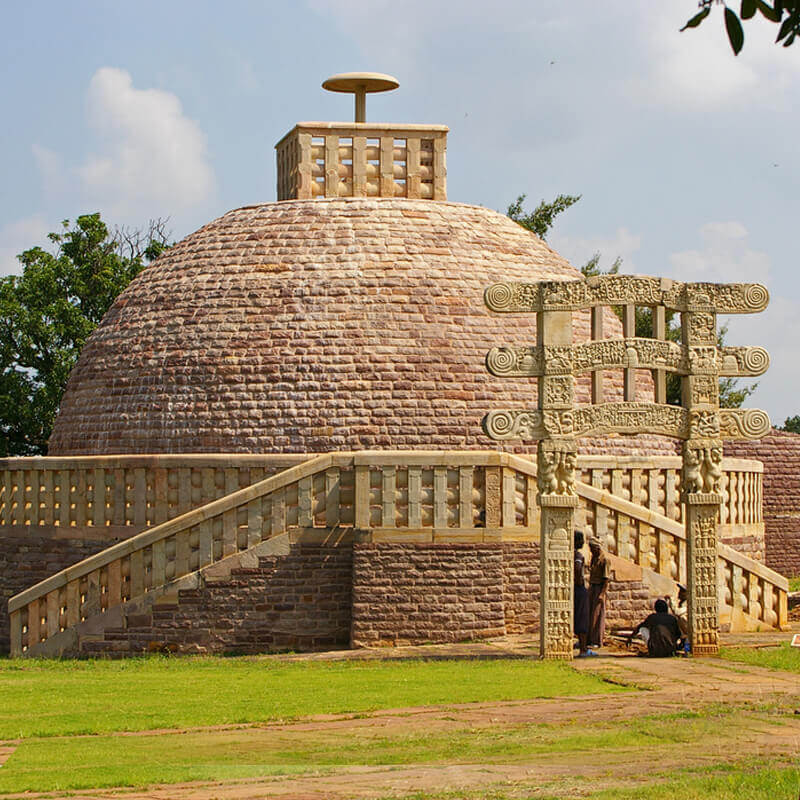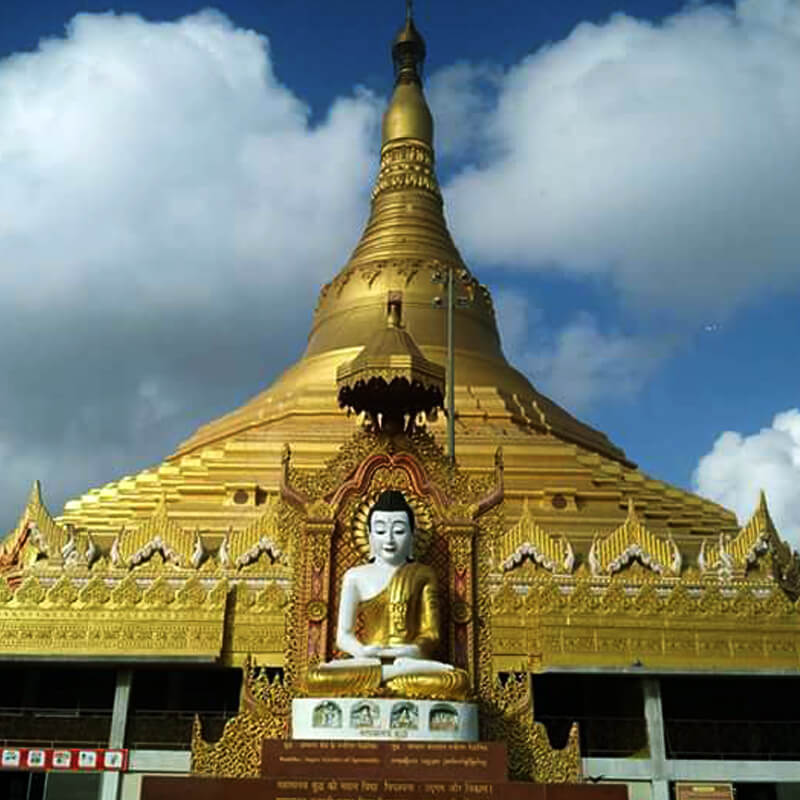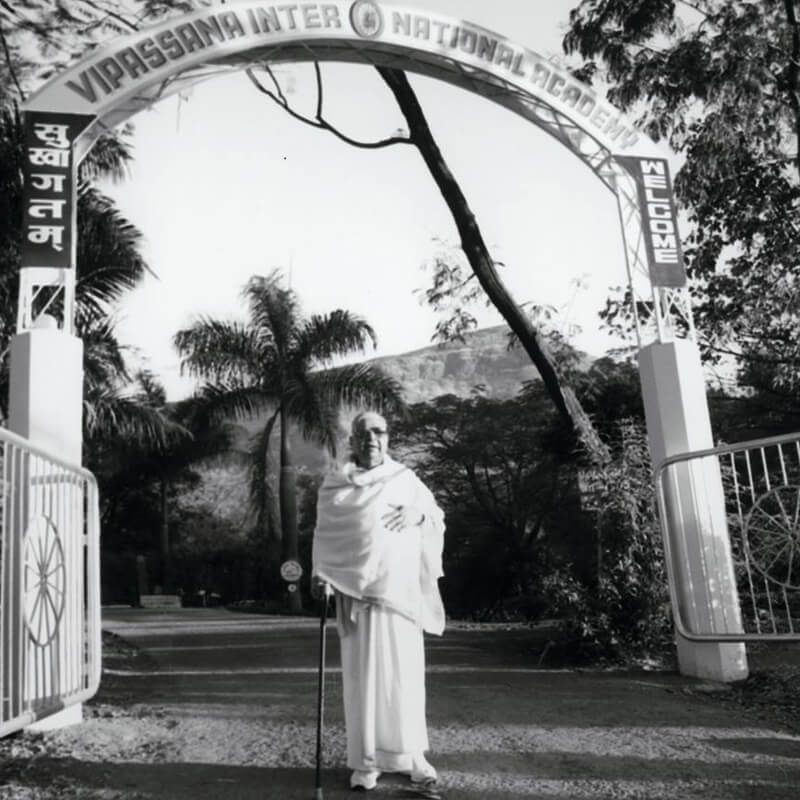Expatriate communities from various South Asian countries came together to organize a Sangha Dana in Los Angeles on 2nd June. This event was planned by U Tin Htoon on behalf of Goenkaji and Mataji. It was a gigantic task to bring together venerable bhikkhus and bhikkhunis from different traditions. U Tin Htoon with the help of Henry Kao and many other selfless volunteers worked hard to make this auspicious event successful. On the day of the Sangha Dana, the venue was filled with more than a thousand people. Goenkaji and Mataji offered food and other requisites to the Sangha.
Ven. Piyananda, the president of Southern California Buddhist Council, gave an introductory speech wherein he informed the audience that he had taken his first ten-day course with Goenkaji in 1973. Goenkaji expressed joy at the opportunity to pay respects to monks from various traditions-a rainbow spectrum. He said that these were branches of the same tree; they all get nutrition from the Buddha-Dhamma, the essence of which is paṭicca-samuppāda (Dependent Origination). The four Noble Truths and the Eightfold Noble Path are accepted as the principal teaching of the Buddha by all. These are acceptable not only by Buddhists but also by all people of all faiths.
Morality, concentration of mind and purity of mind are common to all faiths, all religions. For morality, one-pointed concentration of a wholesome mind, kusala cittassa ekaggatā, is necessary which means the mind should be free from craving and aversion. The Buddha gave a simple technique wherein one concentrates one's mind on the incoming breath and the outgoing breath, keeping one's attention at the tip of the nose (nāsikagge) or just below the nostrils above the upper lip (uttaraoṭṭhassa vemajjhappadese). When one practises in this way, the mind becomes sharp and starts feeling sensations in this area. As a meditator starts observing the realities within, he discovers realities that the Buddha discovered. This cause-and-effect relationship was an unparalleled discovery of the Buddha. Imasmiṃ sati idaṃ hoti, imasmiṃ asati idaṃ na hoti. If this (cause) is present then that (result) comes, if this (cause) is not present then that (result) does not come. In paṭicca-samuppāda, the Buddha explains saḷāyatana paccayā phassa, phassa paccayā vedanā, vedanā paccayā taṇhā-dependent on the six sense doors contact arises, dependent on contact sensations arise and dependent on sensations craving and aversion arise. Goenkaji also spoke about the revival of interest in the Buddha's teaching in India.
In the evening he met Mr. Hover and his wife who had come to Myanmar Monastery in Azusa to see Goenkaji. Mr. Hover was one of the earliest Western students of Sayagyi U Ba Khin. Goenkaji was very happy to see his old friend and. talked with him for a long time.
The next morning was very busy. Goenkaji had to leave the monastery early in the morning to meet Ven. Daw Dhammethi in another monastery. She had hosted the first Vipassana courses that Goenkaji taught after he returned to Myanmar in 1990 after a gap of twenty years. The meeting was interrupted by a phone interview, which was aired live on National Public Radio in Philadelphia.
When Goenkaji returned to the monastery, he was greeted by Ms Hillary McGregor and Bob, a correspondent and a staff photographer for the LA Times. Ms McGregor interviewed Goenkaji in his motor home for an hour as he traveled to the Museum of Tolerance in Los Angeles. Her article "Driven to Enlighten" appeared in the LA Times two days later.
Goenkaji visited the Museum of Tolerance to see for himself how museums use modern technology for educational purposes. The exhibition gallery in the Global Pagoda at Mumbai will be a powerful tool to educate millions of visitors every year about the life of the Buddha and his teaching. Although Goenkaji and Mataji and the other meditators accompanying them knew the gruesome details of the holocaust, they were deeply touched by the immensity of this man-made tragedy when they saw the museum. Tolerance is one of the pāramīs necessary to attain the final goal of full liberation. Tolerance of different cultures, languages, faiths, and ethnic backgrounds; tolerance for actions of others that one finds disturbing; and, above all, tolerance of views that are different from one's own views is important to keep peace in human society. Such tolerance comes naturally when there is love and compassion in the mind.
From the Museum of Tolerance, the Dhamma Caravan left for Dhamma Mahāvana near North Fork. It reached its destination just before midnight. Dhamma Mahāvana was the second centre to host the Dhamma Caravan. He went to Fresno in the evening of 4th June to give a public talk.
Goenkaji explained about the misery we all face in different forms-the misery of birth, disease, old age and death; the misery of losing near and dear ones in wars and natural calamities; the mental trauma in survivors that refuses to heal; the misery of being anxious due to the threat to one's safety and to the safety of one's loved ones. He talked about the senseless killings happening in different parts of the world. Innocent citizens including women and children being killed-not because of any personal enmity but merely because they belong to a particular religious denomination or ethnic community. Vipassana helps one to find peace within oneself in a world where one is tormented by terrorism and war on the one hand and the tendency to delude oneself in sensual entertainment on the other hand.
Whenever Goenkaji stays at a Vipassana centre, he meets the trust members, inquires after various projects and guides Dhamma workers in their meditation practice. On 5th June, Goenkaji had the opportunity to check on various projects at Dhamma Mahāvana and to give guidance. The trust reported on the rapid strides it was taking in the spread of Dhamma. Goenkaji met the trust as a group and also met Dhamma workers individually. Among those who met him were meditators who had been serving in various capacities for many years and were now afflicted with some incurable diseases; meditators who were facing family or financial difficulties; and many who were in good health and were doing well in business. But whether the meditators were facing some serious problems or whether they had just come to pay their respects, all reported that Vipassana has helped them to face the vicissitudes of life with equanimity. They were all smiling.
Goenkaji went to the meditation hall to answer questions from the students of the three-day course. One student asked how could she differentiate between strong determination (adhiṭṭhāna) and attachment. Goenkaji asked her to always have a strong determination when she was doing something that was good for her and good for the society. "But if you fail, smile! If you get upset when you fail in your determination, then you are attached to it." One student asked him how could she remain unaffected by the polluted atmosphere in the West where there were endless distractions. Goenkaji replied, "Like a lotus flower that doesn't allow the muddy water in which it grows to stick to it and blooms in all its beauty and glory."
The next evening, Goenkaji gave a public talk at the Flint Theatre in De Anza College in Cupertino. A lively session of questions and answers followed the talk. To the question, "Why aren't there shorter meditation courses?" Goenkaji said, "Because people want shorter courses, some teachers may decide to teach short courses without any regard for the proper atmosphere and proper training that a new person needs to undergo. In such courses people dabble at the superficial level of the mind. No doubt there are some benefits but one doesn't learn to observe the reality at the depth of the mind. A three-day course is too short a time to reach the depth of mind.
Goenkaji said that he had tried to give short three-day courses of Anapana in the past but found that these were not really benefiting people. Continuity of practice is essential in Vipassana. Short courses don't offer that opportunity. Those who get some benefit may become complacent thinking that now they have understood the whole technique and that there was no need to go any further. Thus, the shorter courses became barriers for them to reach the depth of mind where impurities arise and multiply. There are some who after doing short courses think that this is all there is to the technique and therefore are put off from experiencing Vipassana.
"I want people to really benefit and to come out of all their misery. Therefore, the course has to be long enough to really get to the depth of the mind. Traditionally, until about a century ago, Vipassana was taught in six-week retreats but in these modern times the courses were shortened. When the duration was reduced to ten days it was found that people still got an outline of the technique but if it was reduced further they didn't even get an outline. The pursuit of real happiness is a serious matter. We spend several years in school and college studying things that often have little relevance to our lives but we are so reluctant to take just ten days to look within and learn to live a happy and harmonious life."
A man in his twenties asked whether it was not more important at his age to focus on achieving success in his career, getting married, etc. than striving for the experience of nibbāna? Goenkaji explained how bāna means fire and nibbāna is the total extinguishing of the fire of mental impurities that make us miserable all the time. Goenkaji asked, "Why do you want to burn?" He added that his career would be more successful and family life more peaceful if there is less fire! Vipassana makes a person very active and dynamic but at the same time happy and peaceful.
The Silicon Valley Indian Professionals Association sponsored Goenkaji's talk at Hewlett Packard on 8th June in the morning. The hall was full to its capacity with young computer professionals from Silicon Valley.
Goenkaji explained the importance of mental balance for every section of society but especially so for business people. When one is successful from a worldly point of view, one tends to become self-centred. This, in turn, makes one short-tempered. One cannot tolerate anything that happens against one's wishes. Such a person remains angry and makes the atmosphere at the office very tense. The employees work out of fear and often their talents are not fully utilised. Goenkaji said this was what was happening to him and his staff before he started practicing Vipassana.
When Vipassana was suggested to him as a cure for migraine, he faced two big barriers. Firstly, he thought that this practice was Buddhism and he remembered the words "svadharme nidhanaṃ shreyaṃ, paradharmo bhayāvaho" ("Better to die in one's own religion than to go to any other religion"). When his teacher, Sayagyi U Ba Khin, compassionately explained that Vipassana is nothing but sīla, samādhi and paññā, he was reassured. Goenkaji had already been giving so many discourses on the Gita ideal of sthitaprajña (one established in wisdom) yet he was unable to realize it for himself. He would often say tearful prayers to request more wisdom. His devotional fervor would give him a relatively calm mind for some time. But again the old habit pattern of anger and ego would overcome him. He started seriously searching for something that would take him to the ideal of sthitaprajña. Secondly, he was a very busy person and found it difficult to spare ten days of his life to learn this technique.
When he started practising Vipassana he realized that we make the atmosphere around us tense by generating defilements in the mind. This is mental pollution. Once the mind starts getting purer, the interaction with employees and colleagues changes. There is genuine warmth and goodwill. If there is mental pollution in the office atmosphere, then one burns oneself and burns others-the creative ability of the employees is stunted and their productive energy is wasted due to negative emotions.
Goenkaji told the young professionals that one must develop one's own peace and happiness. This is true self-interest. When one is peaceful, all others around become peaceful and happy. One's peace and happiness helps one's business career as well. Vipassana results in a sharper mind, making one more adept in solving technical and administrative problems.
There were many questions from the young computer professionals, many of whom were hearing about this simple, rational, logical and scientific ancient teaching from India for the first time. Some of them met Goenkaji at the end of the talk and promised to give a trial to Vipassana.
In the evening, Goenkaji gave a talk at the UC Berkeley Zellerbach Auditorium. He explained that Vipassana is a process of exploring the truth within, exploring the mind-matter phenomenon. It is not just to quench the thirst of intellectual curiosity. It was a Berkeley scientist who had made a big contribution to the understanding of how everything in the material structure is mere wavelets, mere vibrations and that there is no solidity in it at all. The Buddha proclaimed this truth more than 2600 years ago. The difference is that the Buddha discovered it without any scientific instruments, when he explored the reality within to find a way out of all suffering. Vipassana is that path out of all suffering. It is self-realization through self-observation. It is the experiential understanding of how one generates misery and how one can come out of it.
When one has craving for something that is pleasant, there is inherent aversion to something that is unpleasant. When one has aversion to something that is unpleasant, there is inherent craving for something that is pleasant.
Later, he answered questions from the audience and gave private interviews. Somebody questioned, "Is this brainwashing?" and Goenkaji replied, "No. It is mind-washing. It purifies your mind and makes you happy and peaceful." Don't get brainwashed! Believe your own experience. And keep working to purify your mind to live a better life." After the talk, Goenkaji and others went up the mountains to the beautiful Anthony Chabot Regional Park where a few wild deer and other animals crossed their path.
Goenkaji had to start early the next day to go to the Jain Temple in Milpitas to give a public talk in Hindi. The temple hall was filled with Indian expatriates. Some of them had heard Goenkaji's talks before but only in English. They were looking forward to hearing from him in Hindi.
Goenkaji explained the word Dharma (Dhamma in Pāli). Dharma means the nature of things. It also means the laws of nature, which when followed, make one happy and peaceful and help to generate love and compassion for others.
All vocal and physical violence starts with violence in the mind. The nature of violence is that whenever the mind generates violence, one becomes agitated and distressed. The nature of non-violence is that whenever the mind generates non-violence, one experiences immense peace and happiness. This requires hard work. One has to work hard to liberate oneself from the bondage of defilements that repeatedly make the mind violent. One who liberates oneself from the bondage of defilements is a vīra. And one who liberates oneself and also helps others to become liberated from the bondage of defilements is called a mahāvīra.
The discourse lasted more than an hour and there were many questions from the audience. To questions about philosophical beliefs in India, Goenkaji remarked that everyone in India is a philosopher but what is the use of all these philosophies if one's life does not reflect one's talk? He also clarified how various misconceptions about the Buddha have harmed Indians. We all believe that the corporeal structure is impermanent (nashvar sharir) but actually there is so much attachment to the body that this body has become "I". This is dehātma buddhi. Similarly one may accept that mind is impermanent but there is so much attachment to it. This is cittātma buddhi. Without understanding what the Buddha really taught, Indians have maligned his teaching and stayed away from it saying he does not believe in God or soul.
Another misconception in the minds of many Indians is that the Buddha was nāstika. Goenkaji explained the original meaning of nāstika. One who doesn't believe in karma and its fruit is a nāstika. When one looks within, one can see for oneself how one forms karma. For centuries, people have been afraid of the Buddha's teaching. Now they are realizing that it is something that helps one come out of fear and makes one fearless. Goenkaji knows about the unfortunate reluctance to give a trial to this wonderful technique that originated in India and made India a world teacher in the field of spirituality. He knows it from his own resistance over fifty years back towards the Buddha's teaching and the resistance of Indians when he started teaching Vipassana in India thirty-three years back.
Goenkaji went to Hayward where about four hundred meditators had gathered for a one-day course on 9th June. One meditator wanted to know about the milestones in meditation. Goenkaji explained that one should give importance only to the present moment. Equanimity is the only yardstick to measure one's progress on the path of Dhamma. To a student who complained of lack of concentration, Goenkaji advised the practice of more Anapana. One meditator was worried about her livelihood. She said that her company is involved in certain practices that are not completely healthy. Goenkaji told her that if she is not involved personally in any unwholesome practices, she should not feel guilty about something over which she has no control.
Almost everyone who takes a ten-day course benefits to some degree and agrees that Vipassana is helpful. But it is difficult to keep the daily meditation practice at home after the course is over. And without continued daily meditation morning and evening, one does not get the optimum benefit from Vipassana. One-day courses and group sittings are very important. They are like "charging the batteries". One gets continued strength and inspiration to maintain daily practice when one joins group sittings and one-day courses.
At Sonoma State University, Goenkaji gave Anapana at the one-day course in the morning and a public talk in the evening on 10th June. When the hall filled up to its capacity and people were still coming in, Vipassana meditators considerately gave up their places in the hall and went to the lobby where the discourse was going to be relayed via closed-circuit TV so that non-meditators could listen to Goenkaji in the hall.
Goenkaji explained how the Buddha's teaching is as relevant today as in the past. The Buddha went to the root of the problem and discovered the solution for liberation from all misery. He realized that we keep reacting to the pleasant and unpleasant sensations with craving and aversion. One remains agitated and miserable because one keeps generating these mental impurities. In his first course, Goenkaji expected to be taught the recitation of the Buddha's name and when that didn't happen, he thought, "What is the use of watching the breath and watching the sensations?" However, it soon became clear to him that breath and sensations are intimately related to the mind and mental impurities. One starts understanding the law of nature: if one defiles one's mind with any impurity such as anger, hatred, lust, and jealousy, one becomes unhappy then and there. On the other hand, if one remains equanimous, one becomes happy and peaceful.
As usual, there were questions from the audience about terror and terrorism and how Vipassana can help. Goenkaji gave the example of Aṇgulimāla at the time of the Buddha. This terrorist had killed 999 human beings and wore a garland made from the fingers of his victims. How cruel, how inhuman! When he was looking for his thousandth victim, he came across the Buddha. The Buddha did not change him with mere sermons. Angulimala learned the same technique, worked hard, and became an arahat, a very saintly person. When Angulimala, now a monk, went around for alms, people recognized him as the murderer of their loved ones. They hit him with sticks and threw stones at him. Blood oozed from the wounds on his body but his mind generated only love and compassion. It was not only Angulimala who got converted in this way. So many contract killers and murderers at the time of the Buddha and after the Buddha came out of violence. Today, Vipassana is bringing similar results among the criminals in various prisons in India, USA and other countries.
Someone from the audience requested Goenkaji to start a Vipassana center in Santa Rosa. Goenkaji laughed and said, "I don't start centres; the meditators do." It is the local meditators who start a centre in any area. Usually the first step in this direction is that the Vipassana meditators in an area come together regularly for weekly group meditation and one-day courses. Then they start organizing ten-day courses under the guidance of an authorized assistant teacher. Once an area hosts a few ten-day courses, and gather enough financial and human resources, the local meditators start looking for a suitable place for a centre.
In the morning of 11th June, Goenkaji gave an interview to New Dimensions Radio. He explained how in spite of coming from a staunch Hindu family with strong prejudice against the teaching of the Buddha, he was attracted to Vipassana. He meditated under the guidance of his teacher, Sayagyi U Ba Khin, from 1955 to 1969. Sayagyi often used to say about Vipassana-"It is very easy and yet it is very difficult. It is very difficult and yet it is very easy." It is easy in the sense that it is simple to follow and practise. But it is difficult because our mind is distracted by so many negativities all the time. So we need to have strong determination to continue on the path of Dhamma.
Explaining the benefits of a ten-day course, Goenkaji said that one feels rejuvenated for some time after one goes on holiday to a resort or beach because one has distracted oneself from the problems that one faces in life. Coming back home, one is subjected to the same tensions and strains and one continues to react in the same deleterious manner as before. Vipassana offers a way to handle stress. One remains fully aware of the world outside and yet one remains aware of one's own mental state inside.
The modern world offers many sensual pleasures and one takes these fleeting pleasures as happiness. One craves for more and more sensual pleasures. The more one is attached to the sensual world the more one becomes fearful and insecure about losing them. As the Buddha said-
Kāmato jāyatī soko, kāmato jāyatī bhayaṃ. From craving arises grief; from craving arises fear.
Therefore, all the modern sensual entertainments make one even more fearful. Vipassana helps one to see the fleeting nature of all worldly pleasures and how they inevitably lead to suffering. One has to learn this from experience. As long as one depends solely on the intellect, one cannot understand Dhamma because the intellect has its limitations. But experience has no limitations. Therefore experiential wisdom is of utmost importance and it alone can give true understanding and true happiness. The interviewer wanted to know whether some of Goenkaji's students have developed any supernatural powers. Goenkaji replied that he has found that supernatural powers can be harmful. One develops ego and attachment to the powers. And one forgets the main goal of purification of mind. As long as the mind is defiled by impurities such as anger, hatred, fear, ego, jealousy, lust, greed etc. even if one has some special abilities one remains a miserable person.
(to be continued)






